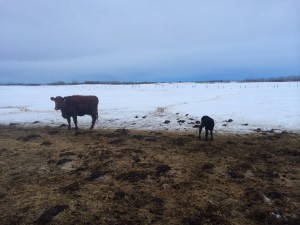Day 1
Calving officially arrived on the afternoon of March 14 here at the farm. Unfortunately, our first cow (R44) had a stillborn calf. She was an older cow--9 years old, and the days leading up to her calving she had shown signs that there was something "not right" with the calf. She did not form a large udder (a cows milk usually comes into the udder a few days prior to calving) until after she calved. We did not throughly investigate the stillborn calf, as the cow was older, which could be a cause, and she would not let us near the calf. This is normal for the cow to stay with her dead calf and "mourn" for a few days.
Day 2
On Saturday we woke up and checked the cows and one heifer (female cow before she has had her first calf ) numbered Z02 had a nice healthy, alive heifer calf. This really lifted my spirits. I know there was not anything I could have done for R44 but my mind always thinks "what if I would of been out here earlier" I usually check the cows every 2-3 hours during the day, so I took the kids out with me at 10:30 am to show them the new baby. The kids always get excited during calving season and love seeing the new babies. There wasn't anyone showing any signs of calving, so we went back in.
We carried on with our morning and had lunch. After lunch I went back out because I wanted to make sure the new little one was up and mom was letting her nurse. A calf has to have the mothers first milk called colostrum to give the calf antibodies to the environment around it as they receive no antibodies from the placenta. When first born, the calf's stomach is porous, allowing proteins from the colostrum to be absorbed. As time goes on after birth, the pores in the stomach wall slowly close up. For maximum antibody protection the colostrum needs to be consumed within the first 6 hours of birth. When I went back out, I found another heifer (Z21) that had just had her calf. The calf was still wet, but her mom was licking her off. After the calf is born, the cow licks it off, this not only stimulates and warms the new calf. It also helps the mom bond with her baby, transfer her scent to it, and helps her recognize the features of the new calf that identify it as hers. I left the new mom and baby alone to bond. I continued to check every 2-3 hours on our two new pairs. Everyone was doing well and we did our last check at 9:30 pm when we got home from supper at our local community hall.



No comments:
Post a Comment